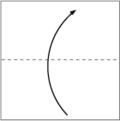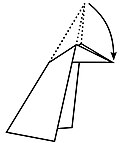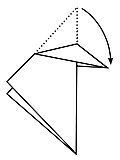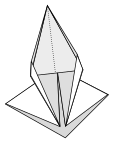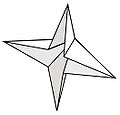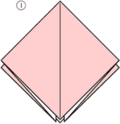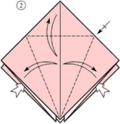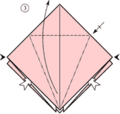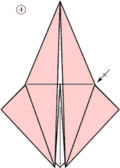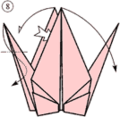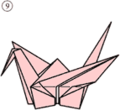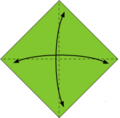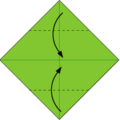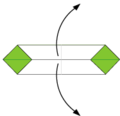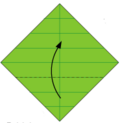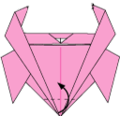Difference between revisions of "AY Honors/Origami/Answer Key"
nad>Jomegat |
|||
| Line 119: | Line 119: | ||
==5. Do three of the following models:== | ==5. Do three of the following models:== | ||
{{TODO|Wait - I gotta get some paper and fold 'em and take pictures ... or, YOU can ...}} | {{TODO|Wait - I gotta get some paper and fold 'em and take pictures ... or, YOU can ...}} | ||
| − | ===a. House=== | + | ===a. House=== |
| + | http://www.wikihow.com/Make-an-Origami-House | ||
| + | |||
===b. Lotus blossom === | ===b. Lotus blossom === | ||
===c. Cicada === | ===c. Cicada === | ||
Revision as of 23:48, 7 April 2013
1. What is Origami? Where did it come from? How was it used and developed?
What is Origami?
Origami (derived from "ori" meaning "to fold", and "kami", meaning paper, and changed to voiced sound "gami") is the ancient Japanese art of paper folding. The goal of this art is to create a given result using geometric folds and crease patterns preferably without the use of gluing or cutting the paper medium. "Origami" refers to all types of paper folding, even those of non-Asian origin.
Where did it come from?
How was it used and developed?
2. Identify the symbols for the following terms:
Note: Almost every origami book has basic instructions and a set of folding symbols.
a. Valley fold
b. Mountain fold
c. Cut
Hmmm - ... preferably without the use of gluing or cutting the paper medium.
d. Existing crease
e. Hold here
f. Watch this spot
g. In front
h. Behind
i. Tuck in, open out, or apply force
j. Fold over and over
Fold over and over symbol at http://www.oriland.com/oriversity/symbols/main.asp
k. Turn model over
3. Demonstrate folding the following folds:
a. Reverse fold
- An outside reverse fold consists of two radial valley folds extending from a single point on a central fold and a reversal of the center fold on the affected end, all done simultaneously.
- An inside reverse fold consists of two radial mountain folds extending from a single point on a central fold, and a reversal of the central fold on the affected end, all done simultaneously.
b. Squash fold
- A squash fold starts with a flap with at least two layers (for example, one flap of a waterbomb base). Make a radial fold from the closed point down the center of this flap. Open the flap and refold downward to make two adjacent flaps.
c. Petal fold
- A petal fold starts with two connected flaps, each of which has at least two layers. (For example, two flaps of a preliminary base). The two flaps are attached to each other along a reference crease. Make two radial folds from the open point, so that the open edges lie along the reference crease. Unfold these two radial folds. Make another fold across the top connecting the ends of the creases to create a triangle of creases. Unfold this fold as well. Fold one layer of the open point upward and flatten it using the existing creases. A petal fold is equivalent to two side-by-side rabbit ears, which are connected along the reference crease.
d. Book fold
See example at http://www.folds.net/tutorial/folds/book/book_diagrams.html
e. Preliminary fold
- The preliminary fold consists of two perpendicular diagonal mountain folds that bisect the corners of the square and two perpendicular valley folds that bisect the edges of the square. The paper is then collapsed to form a square shape with four isosceles-right triangular flaps.
f. Blintz fold
- A blintz fold is made by folding the corners of a square into the center. This can be achieved with higher accuracy by folding and unfolding two reference creases through the center.
4. Demonstrate folding the following bases:
In origami, there is a series of several bases that many models are created with. In general, "base" refers to any folded paper that immediately precedes final folding and shaping of the model-to-be.
a. Bird base
- The bird base, or crane base, consists of a preliminary fold with both the front and the back sides petal folded upward.
b. Waterbomb base
- The waterbomb base consists of two perpendicular valley folds down the diagonals of the square and two perpendicular mountain folds down the center of the square. This crease pattern is then compressed to form the waterbomb base, which is an isosceles-right triangle with four isosceles-right triangular flaps. The waterbomb base is an inside-out preliminary fold.
c. Frog base
- The frog base starts with a waterbomb base or preliminary fold. All four flaps are squash-folded (the result is the same in either case), and then the corners are petal folded upward.
Other Bases
- The kite base is merely two valley folds that bring two adjacent edges of the square together to lie on the square's diagonal.
- The fish base consists of two radial folds against a diagonal reference crease on each of two opposite corners. The flaps that result on the other two corners are carefully folded downwards in the same direction. In other words, it consists of two side-by-side rabbit ears.
If a square is blintz folded, then a kite/fish/bird/frog base is folded, and the blintzed edges teased out and collapsed n a certain fashion, this is called a blintzed kite/fish/bird/frog/base, which doubles the complexity and adds more points and edges to the original kite/fish/bird/frog base, for a more complex model that requires more points. It's possible to double blintz for a double blintzed kite/fish/bird/frog base if needed. Theoretically an infinite number of blintzes could be performed to yield an infinitely complex multipointed base, but paper thickness restricts this to generally two blintzes.
5. Do three of the following models:
a. House
http://www.wikihow.com/Make-an-Origami-House
b. Lotus blossom
c. Cicada
d. Housefly
e. Butterfly
http://museum.nhm.uga.edu/htmldocs/origamibutterfly.html
6. Choose three of the following models to fold or select similar models from Origami books:
Here's a paper rose from WikiHow:
a. Jumping Frog
Here are a couple of links to WikiHow for making a jumping frog:
- http://www.wikihow.com/Make-an-Origami-Jumping-Frog
- http://www.wikihow.com/Make-an-Origami-Jumping-Frog-from-an-Index-Card
b. Carrier Pigeon
c. Sailboat
d. Hen
e. Leaf
f. Walking dog
g. Duck
7. Fold one model of your choice from memory from requirement 5 or 6.
8. Illustrate a Bible story using several Origami models.
- Noah: ark (house on boat?) & bird
- Creation (you choose a variety of animals and make a male and female of each)
- Daniel's Lions
- Jesus' Parable of the lost sheep (you might NOT want to make 100 sheep, so think carefully through implementation). Rocks and bushes are foldable items and might privide a place to "hide" the sheep that the shepherd is finding.
- The four beasts of Daniel 7 (for advanced folders!)
Other
Found these images, but they are not #5 or #6 above




